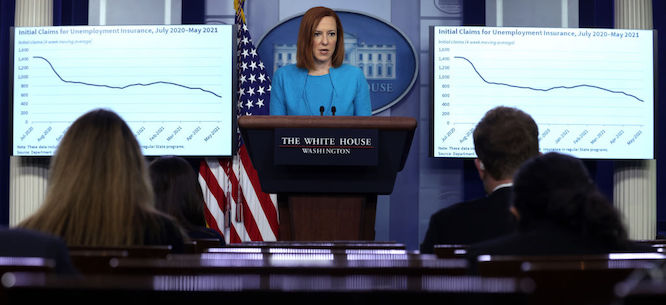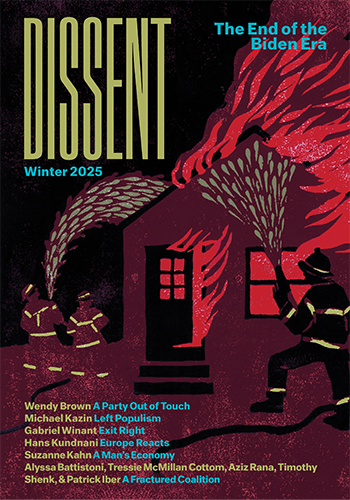The Early End of Unemployment Insurance Is Class War
The Early End of Unemployment Insurance Is Class War
If the Biden administration were serious about helping workers to build power, it would push back against the Republican governors who are ending pandemic unemployment programs early.

In recent weeks, the Biden administration has announced reductions in both its proposed infrastructure spending and corporate income tax increase. But perhaps most painful for working-class people in the Democratic coalition were the messages from the White House on unemployment delivered on June 4. When asked whether President Biden believed pandemic unemployment insurance was holding people back from returning to work, Press Secretary Jennifer Psaki said governors “have every right . . . to pull back on unemployment benefits or not accept them.”
Liberal concern about the early cancellations of payment programs has focused on reductions in consumer spending. It is said that ending unemployment insurance will “hurt the recovery.” This is true: there will be fewer customers for businesses in states where the payments end. A stream of consumer spending will dry up. But equally worrying is the reduced power of workers in these states.
Across the country, workers have used the health and safety concerns posed by the pandemic and the enhanced unemployment insurance provided by the CARES Act to renegotiate the basic social contract that governs the American workplace. As social-distancing restrictions end and employers look to meet customer demand, pandemic unemployment benefits—which increase the amount in weekly income and the length of time that workers can claim it—have empowered working people across the economy.
Nationally, wages at the bottom of the labor market experienced a huge jump in April 2020 and continued to rise. Average hourly earnings in retail are up a dollar since May 2020, and over $1.50 since before the pandemic. In education, hourly earnings are up ninety cents since May 2020. As one indication of confidence in individual bargaining, workers are quitting at a historically high rate. Four million workers, nearly 3 percent of the labor force, voluntarily left employment in April. Workers who quit are not eligible for unemployment insurance: they are changing jobs to look for better pay and treatment.
The Biden administration has professed a commitment to creating a bargaining environment more favorable to workers. “It is the policy of my Administration to encourage worker organizing and collective bargaining,” the president wrote in his April Executive Order on Worker Organizing and Empowerment, which established a cabinet-level task force to promote those goals. The purpose of the order is to determine how the administration can begin to reverse the decline in union membership, to which the White House attributes “serious societal and economic problems in our country,” including “widespread and deep economic inequality, stagnant real wages, and the shrinking of America’s middle class.”
These goals are running aground in the face of a now ubiquitous talking point: according to the nation’s business press and cable news channels, a “labor shortage” created by workers’ increased bargaining power is holding back growth of the post-pandemic economy.
In May, governors in twenty-five states moved to ease hiring at this bottom layer of the labor market by announcing the early end of federal unemployment insurance payments established by the CARES Act, which include extended weeks to beneficiaries, benefits for independent contractors, and the additional $300 in weekly top-up payments. Last Saturday, Missouri, Iowa, Alaska, and Mississippi ended their participation in these federal programs meaning 300,000 workers will lose income. On June 19, eight more states—Alabama, Idaho, Indiana, Nebraska, New Hampshire, North Dakota, West Virginia, and Wyoming—will follow suit. The following week, ten more states will join the ranks of early termination, with three other states to follow in July. Under the CARES Act, these federal benefits are intended to expire in the first week of September.
Union leaders in the affected states have lashed out at the cuts as a form of class war. When South Carolina governor Henry McMaster announced he would terminate the federally funded programs, state AFL-CIO president Charles Brave said the governor was in the pocket of the “business community.” The benefits should not be cut off without raising the state’s minimum wage law, the state labor federation argued. “If an extra $300 a week in unemployment is more fruitful to you than returning to work, what does that say about the wages we pay working people in general across this state?” Indiana AFL-CIO President Brett Voorhies said his state’s governor was “trying to coerce Hoosiers into low-paying jobs.” The AFL-CIO of Florida said that “Ending federal pandemic assistance is a short-sighted and mean-spirited piece of politically driven policy that does nothing to address the long-term issues facing our state and our working people.” Iowa AFL-CIO president Charlie Wishman described his state governor’s parallel announcement as a “shameful” and “punitive” move that “shows a misunderstanding of what’s actually going on in Iowa’s economy in the short and long term.”
According to the staff of the Democratic members of the Joint Economic Committee in Washington, who used the Department of Labor’s administrative data to estimate the amount lost to individuals and to local economies from the early benefits cut off, ending the $300 weekly payments provided by Pandemic Unemployment Compensation (PUC)—one of the three federal programs—would cost over $8 billion dollars to individuals. Andrew Stettner of the Century Foundation estimates that early termination of all three programs in the twenty-five states will affect over 4 million workers, at a total cost of over $22 billion to individuals.
While governors may end the $300 weekly checks at their discretion, the Pandemic Unemployment Assistance (PUA) program, which provides up to thirty-nine weeks of federally financed benefits at an amount equal to at least half the states’ regular weekly UI payments, can only be terminated by the Department of Labor. Unless Congress changes the law, the DOL is responsible for ensuring people get these benefits. In May, the National Employment Law Project wrote to Labor Secretary Marty Walsh urging the department to preserve the program. NELP also suggests a more daring option: for the DOL to cooperate with state governments where governors are not ending PUA programs to offer benefits to workers in those states where governors are cutting off payments. This would circumvent the governors’ offices that have turned against beneficiaries. “In order to entice other States to administer these PUA claims for out of state claimants, the DOL could use a portion of the $2 billion in funds appropriated to it in the American Rescue Plan to provide one time grants and/or administrative funding to these states,” NELP wrote to Walsh. To date, the Department of Labor has not signaled it has any intention to take up this idea.
Right now, over 11 million Americans depend directly on the White House for weekly income under PUA and Pandemic Emergency Unemployment Compensation, which provides benefits for independent contractors. If the Biden administration were serious about its Executive Order to Strengthen Worker Organizing and Empowerment, one place to begin to focus workers’ attention would be on the political representatives of local employers in each of the state governments where benefits are being terminated prematurely and illegally. Instead, the message it has sent workers in twenty-five states is that help will not come from Washington.
On a longer horizon, the nature of the recovery will rise and fall with the administration’s program to strengthen workers’ hand in the labor market. Since the 1930s, the Keynesian diagnosis of the American economy has been that private spending alone is unable to produce full employment, because of the highly unequal distribution of income produced by the corporate economy. Those who earn most of the income spend the least of it, proportional to their share. Large corporations’ earnings far outpace physical investment and employment; they pool money rather than spread it around through purchases and payrolls. Building worker power to force this money into wages is an indispensable part of any worthwhile economic program, especially a program designed to get the country out of a recession. Many of those workers cut off from federal benefits now face almost certain joblessness. Since December, the adjusted monthly employment gains have ranged from 200,000 to 600,000 workers. To absorb the 4 million people who governors are removing from unemployment insurance this month, employers would have to step up hiring tenfold above recent rates.
The palpable desire for working-class power in the United States marks an undeniable change in the national mood from the Obama years. Yet the White House still seems to be pursuing some elusive bipartisan consensus. Allowing states to withdraw $22 billion in spending on direct income support for workers underlines the current weakness of that program, as did its decision earlier in the spring not to use the Democratic majority to push for a budget reconciliation that would raise taxes on corporations and the wealthy and push for infrastructure spending. For a short time, enhanced unemployment insurance has altered the balance of power in the American workplace. Now, workers hoping to build power will face a much more difficult landscape, as will the Democratic Party as it tries to find a path to victory in next years’ midterm elections.
Andrew Elrod recently completed a dissertation on the history of wage and price controls in the U.S. after the Second World War. He lives in Los Angeles.




